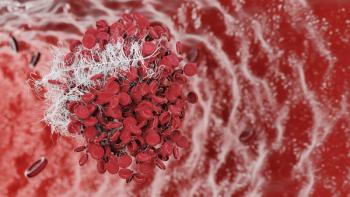
Nilotinib Therapy May Be More Likely to Produce Major Molecular Response in Chronic Myeloid Leukemia Patients
Newly diagnosed chronic myeloid leukemia patients may be more likely to achieve major molecular response if they receive nilotinib therapy, a new study suggests.
Newly diagnosed chronic myeloid leukemia patients may be more likely to achieve major molecular response if they receive nilotinib therapy, a new study suggests.
In the first year of chronic myeloid leukemia chronic phase treatment, nilotinib therapy is estimated to have a better chance of eliciting major molecular response than dasatinib or imatinib, the results of a study suggest.
A meta-analysis published in the March 2014 edition of Cancer Treatment Review measured treatment effects relative to imatinib, and included a trial of nilotinib and imatinib, and 2 trials of dasatinib and imatinib. Participants in each trial received imatinib 400 mg once daily and either nilotinib 300 mg twice daily or dasatinib 100 mg once daily.
The analysis measured major molecular response to therapies, by gauging the measure as reported by 12 months and at 12 months. According to the researches, major molecular response by 12 months can mean achieving major molecular response at any date prior to the 12-month marker, and also allows patients to attain and later lose that outcome. Meanwhile, assessments of major molecular response at 12 months gauged whether a patient achieved and maintained major molecular response on the date of the 12-month assessment.
Within the 3 trials, 12-month major molecular response rates were higher in the nilotinib and dasatinib arm than in the imatinib arms. In the trial of nilotinib and imatinib, the major molecular response rate by 12 months was 55% for participants receiving nilotinib, and 27% in participants receiving imatinib. Meanwhile, the rates of major molecular response at 12 months were 44% for the nilotinib arm and 22% for the imatinib arm.
In the first dasatinib and imatinib trial, 46% of dasatinib participants attained major molecular response by 12 months, compared with 28% of imatinib participants. In the second trial, 47% of participants in the dasatinib arm achieved major molecular response at 12 months, whereas 33% of imatinib participants achieved major molecular response at the same time.
The absolute differences in major molecular response rates between nilotinib and dasatinib were similar in both the by and at month 12 analyses, hovering around 10%. When researchers pooled data from all 3 trials and adjusted for the differences in at versus by results, nilotinib had a 97% chance of providing the highest major molecular response rate. Dasatinib had a 3% chance of providing the highest molecular response rate, and imatinib had no chance of providing the highest molecular response rate, researchers reported.
The estimated rates of major molecular response by month 12 and at month 12 also tended to favor nilotinib, with 55.2% of participants estimated to achieve the mark by month 12, and 44.2% of participants estimated to have major molecular response at month 12.
The researchers disclosed receiving funding from Novartis Pharmaceuticals Corporation to conduct the study.
Newsletter
Stay informed on drug updates, treatment guidelines, and pharmacy practice trends—subscribe to Pharmacy Times for weekly clinical insights.










































































































































































































